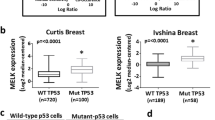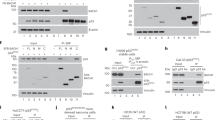Abstract
BAG-1 is an anti-apoptotic protein that interacts with Bcl-2, Bcl-XL, Hsp70/Hsc70, Raf-1 and numerous hormone or growth factor receptors. Recently, BAG-1 has been found to be overexpressed in a variety of human cancer cell lines and some tumors. However, the molecular mechanism of BAG-1 upregulation is still unclear. In this study, we cloned 0.9 kb of human genomic DNA, BGEV, 5′ flanking the BAG-1 open reading frame. BGEV subcloned into a promoterless luciferase reporter vector conferred high promoter activity in various human cancer cell lines. Deletion analysis of this sequence localized the region of maximal BAG-1 promoter activity from nucleotide positions −353 to −54, upstream of the first start codon CTG. Sequence analysis of the BAG-1 promoter region showed the absence of a TATA box but identified a CCAAT box, several GC boxes, a CpG island and several transcriptional factor binding sites, which may be important in the regulation of BAG-1 transcription. Most importantly, functional characterization of the BAG-1 promoter in vivo demonstrated that gain-of-function p53 mutants derived from human tumors upregulated the transcription of BAG-1 RNA and the expression of a reporter gene from the BAG-1 promoter. These results indicated that we have isolated the functional constitutive BAG-1 promoter. Furthermore, the data suggested that overexpression of BAG-1 in some tumors may be due to upregulation of the human BAG-1 promoter by mutant p53.
This is a preview of subscription content, access via your institution
Access options
Subscribe to this journal
Receive 50 print issues and online access
$259.00 per year
only $5.18 per issue
Buy this article
- Purchase on Springer Link
- Instant access to full article PDF
Prices may be subject to local taxes which are calculated during checkout







Similar content being viewed by others
References
Agoff SN, Hou J, Linzer DI and Wu B. . 1993 Science 259: 84–87.
Bardelli A, Longati P, Albero D, Goruppi S, Schneider C, Ponzetto C and Comoglio PM. . 1996 EMBO J. 15: 6205–6212.
Bargonetti J, Chicas A, White D and Prives C. . 1997 Cell Mol. Biol. 43: 935–949.
Baylin SB, Herman JG, Graff JR, Vertino PM and Issa JP. . 1998 Adv. Cancer Res. 72: 141–196.
Blandino G, Levine AJ and Oren M. . 1999 Oncogene 18: 477–485.
Chen HM and Boxer LM. . 1995 Mol. Cell Biol. 15: 3840–3847.
Chin KV, Ueda K, Pastan I and Gottesman MM. . 1992 Science 255: 459–462.
Deb S, Jackson CT, Subler MA and Martin DW. . 1992 J. Virol. 66: 6164–6170.
Dittmer D, Pati S, Zambetti G, Chu S, Tereseky K, Moore M, Finlay C and Levine AJ. . 1993 Nature Genet. 4: 42–46.
Frazier MW, He X, Wang J, Gu Z, Cleveland JL and Zambetti GP. . 1998 Mol. Cell. Biol. 18: 3735–3743.
Froesch BA, Takayama S and Reed JC. . 1998 J. Biol. Chem. 273: 11660–11666.
Ginsberg D, Mechta F, Yaniv M and Oren M. . 1991 Proc. Natl. Acad Sci. USA 88: 9979–9983.
Gopalkrishnan RV, Lam EWF and Kedinger C. . 1998 J. Biol. Chem. 273: 10972–10978.
Grillot DA, Gonzalez-Garcia M, Ekhterae D, Duan L, Inohara N, Ohta S, Seldin MF and Nunez G. . 1997 J. Immunol. 158: 4750–4757.
Haldar S, Negrini M, Monne M, Sabbioni S and Croce CM. . 1994 Cancer Res. 54: 2095–2097.
Heckman C, Mochon E, Arcinas M and Boxer LM. . 1997 J. Biol. Chem. 272: 19609–19614.
Hinds PW, Finlay CA, Quartin RS, Baker SJ, Fearon ER, Vogelstein B and Levine AJ. . 1990 Cell Growth Differ. 1: 571–580.
Hirose Y, Yoshimi N, Suzui M, Kawabata K, Tanaka T and Mori H. . 1997 Mol. Carcinog. 19: 25–30, 1997.
Hollstein M, Sidransky D, Vogelstein B and Harris CC. . 1991 Science 253: 49–53.
Ikegaki N, Katsumata M, Minna J and Tsujimoto Y. . 1994 Cancer Res. 54: 6–8.
Ji C, Casinghino S, McCarthy TL and Centrella M. . 1996 J. Cell. Biochem. 63: 478–490.
Kullmann M, Schneikert J, Moll J, Heck S, Zeiner M, Gehring U and Cato AC. . 1998 J. Biol. Chem. 273: 14620–14625.
Laird PW and Jaenisch R. . 1996 Annu. Rev. Genet. 30: 441–464.
Lanyi A, Deb D, Seymour RC, Ludes-Meyers JH, Subler MA and Deb S. . 1998 Oncogene 16: 3169–3176.
Levine AJ. . 1997 Cell 88: 323–331.
Li R, Sutphin PD, Schwartz D, Matus D, Almog N, Wolkowicz R, Goldfinger N, Pei H, Prokocimer M and Rotter V. . 1998 Oncogene 16: 3269–3277.
Miyashita T, Harigai M, Handa M and Reed JC. . 1994a Cancer Res. 54: 3131–3135.
Miyashita T, Krajewski S, Krajewska M, Wang HG, Lin HK, Liebermann DA, Hoffman B and Reed JC. . 1994b Oncogene 9: 1799–1805.
Miyashita T and Reed JC. . 1995 Cell 80: 293–299.
Negrini M, Silini E, Kozak C, Tsujimoto Y and Croce C. . 1987 Cell 49: 455–463.
Orrenius S. . 1995 J. Internal. Med. 237: 529–536.
Rampino N, Yamamoto H, Ionov Y, Li Y, Sawai H, Reed JC and Perucho M. . 1997 Science 275: 967–969.
Ryan KM and Vousden KH. . 1998 Mol. Cell Biol. 18: 3692–3698.
Shiio Y, Yamamoto T and Yamaguchi N. . 1992 Proc. Natl. Acad. Sci. USA 89: 5206–5210.
Subler MA, Martin DW and Deb S. . 1994 J. Virol. 68: 103–110.
Takayama S, Sato T, Krajewski S, Kochel K, Irie S, Millan JA and Reed JC. . 1995 Cell 80: 279–284.
Takayama S, Bimston DN, Matsuzawa S, Freeman BC, Aime-Sempe C, Xie Z, Morimoto RI and Reed JC. . 1997 EMBO J. 16: 4887–4896.
Takayama S, Krajewski S, Krajewska M, Kitada S, Zapata JM, Kochel K, Knee D, Scudiero D, Tudor G, Miller GJ, Miyashita T, Yamada M and Reed JC. . 1998 Cancer Res. 58: 3116–3131.
Thompson CB. . 1995 Science 267: 1456–1462.
Tsutsumi-Ishii Y, Tadokoro K, Hanaoka F and Tsuchida N. . 1995 Cell Growth Differ. 6: 1–8.
Yang X, Nakao Y, Pater MM, Tang S-C and Pater A. . 1997 J. Cell. Biochem. 66: 309–321.
Yang X, Chernenko G, Hao Y, Ding Z, Pater MM, Pater A and Tang S-C. . 1998 Oncogene 17: 981–989.
Zapata JM, Krajewska M, Krajewski S, Huang RP, Takayama S, Wang HG, Adamson E and Reed JC. . 1998 Breast Cancer Res. Treat. 47: 129–140.
Zeiner M and Gehring U. . 1995 Proc. Natl. Acad. Sci. USA 92: 11465–11469.
Acknowledgements
We thank Y Hao and G Chernenko for excellent technical assistance and Drs B Vogelstein, KH Vousden and GP Zambetti for providing mutant p53 plasmids. The investigation was supported by grants from the Medical Research Council of Canada and a grant from the National Cancer Institute of Canada with funds from the Canadian Cancer Society.
Author information
Authors and Affiliations
Rights and permissions
About this article
Cite this article
Yang, X., Pater, A. & Tang, SC. Cloning and characterization of the human BAG-1 gene promoter: upregulation by tumor-derived p53 mutants. Oncogene 18, 4546–4553 (1999). https://doi.org/10.1038/sj.onc.1202843
Received:
Revised:
Accepted:
Published:
Issue Date:
DOI: https://doi.org/10.1038/sj.onc.1202843
Keywords
This article is cited by
-
Molecular changes in solitary fibrous tumor progression
Journal of Molecular Medicine (2019)
-
Mutant p53-R273H mediates cancer cell survival and anoikis resistance through AKT-dependent suppression of BCL2-modifying factor (BMF)
Cell Death & Disease (2015)
-
Co-overexpression of Bag-1 and heat shock protein 70 in human epidermal squamous cell carcinoma: Bag-1-mediated resistance to 5-fluorouracil-induced apoptosis
British Journal of Cancer (2011)
-
When mutants gain new powers: news from the mutant p53 field
Nature Reviews Cancer (2009)
-
Interactions of mutant p53 with DNA: guilt by association
Oncogene (2007)



